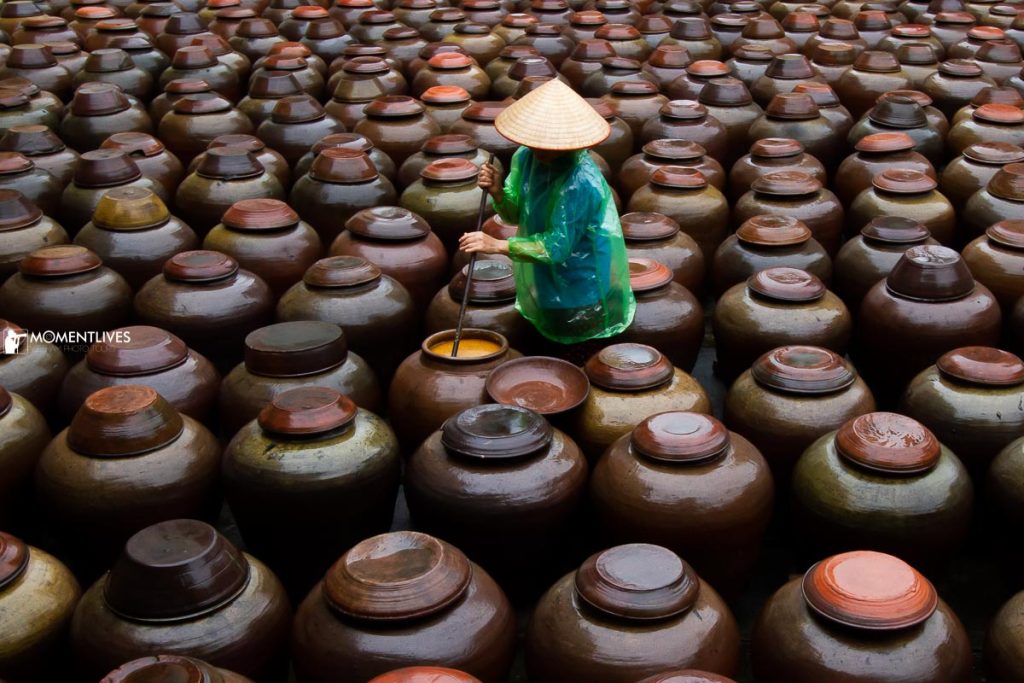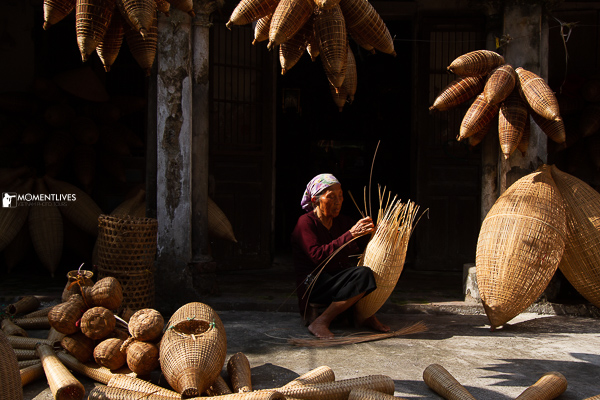Step into the soul of Northern Vietnam’s countryside with photo tours through three traditional villages on the outskirts of Hanoi
Just beyond the rapid hum of Hanoi lies another world – one of earthy scents, warm textures, and ancestral rhythm. Scattered across the fertile plains of the Red River Delta are villages where ancient crafts are still lovingly practiced by hand. Whether it’s the meditative act of weaving bamboo traps, the slow brewing of umami-rich soy sauce, or the striking visuals of incense drying under the sun, these villages preserve Vietnam’s cultural soul through every gesture.
Let’s take a photographic journey with Momentlives through three such places: Quang Phu Cau, Ban Yen Nhan, and Thu Sy.
Each of these villages preserves a sensory layer of Vietnamese heritage – the fragrance of incense, the savory scent of soy sauce, the tactile beauty of bamboo weaving. More than just craft production hubs, they are living communities where knowledge, skill, and identity are passed down through daily practice.
Momentlives are excited to share our own photographic perspective of these villages. Their beauty lies not only in what they produce, but in the stories behind every hand movement, every sun-dried tray, and every jar or basket made under open skies.
Quang Phu Cau – incense sticks village near Hanoi
 Located 35 kilometers southwest of Hanoi, Quang Phu Cau is just over an hour from the capital. Surrounded by rice fields and canals, the village is famous for vivid red incense stick displays that bloom like giant chrysanthemums in every courtyard.
Located 35 kilometers southwest of Hanoi, Quang Phu Cau is just over an hour from the capital. Surrounded by rice fields and canals, the village is famous for vivid red incense stick displays that bloom like giant chrysanthemums in every courtyard.
Home to nearly 300 households, Quang Phu Cau is one of northern Vietnam’s largest incense-making localities. The craft has existed for more than 100 years, producing 7–9 tons of incense sticks daily, with some families reaching 15 tons. Products are exported to markets including the Myanmar, Thailand, Malaysia, Nepal, Pakistan, and the Middle East.
Incense holds a sacred role in Vietnamese culture, burned at ancestral altars, temples, funerals, and festivals. Each stick has two parts: a bamboo core and a coating of aromatic herbal powder such as cinnamon, sandalwood, star anise, and clove.
The entire process takes place in Quang Phu Cau: splitting mature bamboo (about 200 tons consumed daily), dyeing, drying, rolling, and bundling. Dyed red or pink, sticks are laid out under the sun, creating the village’s iconic visual displays. While machinery now helps apply incense paste and slice bamboo, much remains labor-intensive. Modernization has increased productivity three to four times, with each worker producing 15–20 kg of finished sticks daily.
Drying, however, still depends heavily on weather. A sunny day ensures quality, while rain or humidity can ruin thousands of sticks.
Ban Yen Nhan – Where the fragrance of soy sauce lingers
 Located about 40 kilometers east of Hanoi, Ban Yen Nhan is home to one of Vietnam’s most storied culinary traditions. With a history of more than 700 years, tương Bần (soy sauce) has become an integral part of the region’s cultural identity. In the 13th century, it was even offered as a tribute to the king. The art of natural fermentation in clay jars is regarded as a treasured craft, passed down through generations. Today, around 300 people in the village are involved in making soy sauce on daily basis.
Located about 40 kilometers east of Hanoi, Ban Yen Nhan is home to one of Vietnam’s most storied culinary traditions. With a history of more than 700 years, tương Bần (soy sauce) has become an integral part of the region’s cultural identity. In the 13th century, it was even offered as a tribute to the king. The art of natural fermentation in clay jars is regarded as a treasured craft, passed down through generations. Today, around 300 people in the village are involved in making soy sauce on daily basis.
The soy sauce is made mainly from glutinous rice and soybeans, through a slow and labor-intensive process entirely reliant on natural elements. Each batch requires skill and careful attention, guided by experience handed down within families. Production involves three key stages: fermenting sticky rice to develop mold, preparing the soybeans, and aging the mixture.
First, sticky rice is soaked, cooked until soft and glutinous, and left to ferment. The rice must develop a fine white mold in a carefully controlled environment, neither too hot nor too humid, to ensure the right kind of fermentation. Any contamination with unwanted mold can spoil the entire batch. When the mold spreads evenly, the grains are gently separated by hand, then covered with fabric and longan leaves to continue fermenting until the desired quality is reached.
The soybeans, meanwhile, are rinsed thoroughly until the water runs clear, with damaged beans removed. Roasting is another critical step: the beans are stirred continuously in a thick-bottomed pan to ensure even roasting without burning. Once cooled, they are finely ground to blend smoothly with the moldy rice.
Finally, the ingredients are combined and aged. The balance of salt, water, and fermented rice is crucial to the sauce’s signature flavor – rich, sweet, and aromatic. For every 100-liter jar, artisans use 30 kilograms of mold-fermented sticky rice, 10 kilograms of ground soybeans, and 15 kilograms of salt.
In Ban village, it is common to see ceramic jars that are 50 to 70 years old. Soy sauce matured in these timeworn vessels develops a deeper, sweeter, and more distinctive flavor than that aged in modern containers.
Thu Sy fishing trap village – traditional bamboo craft in Northern Vietnam
In Hung Yen province, about 60 kilometers southeast of Hanoi, lies Thu Sy Village, best known for its centuries-old tradition of hand-weaving bamboo fishing traps. Nestled along tributaries of the Red River, the village has long relied on fishing as a way of life, and the tools for it were proudly handmade.
The craft’s exact origins are unknown, but weaving traps is deeply tied to both agricultural and riverine culture. Villagers once produced not only for their own use but also for neighboring provinces, supplying tools such as “đơm,” “lờ,” and “dậm.” For generations, it was both a livelihood and a communal activity, with elderly men and women gathering in courtyards to weave and share stories. Today, about 500 people are still involved in the craft.
 The main raw material, mature bamboo or neohouzeaua, was once sourced locally but now comes from other provinces. Preparing it requires skill: artisans split bamboo into strips of varying widths and thicknesses, sorted carefully before weaving begins. The strips are coiled into circular shapes, with longer ones running from end to end and shorter connecting strips binding them together. Weaving starts at the center and works outward, forming the trap’s distinctive oval body with a wide mouth and pointed tail. For smoked versions, the traps are dried over straw, taking on a glossy amber-brown finish that enhances both strength and beauty.
The main raw material, mature bamboo or neohouzeaua, was once sourced locally but now comes from other provinces. Preparing it requires skill: artisans split bamboo into strips of varying widths and thicknesses, sorted carefully before weaving begins. The strips are coiled into circular shapes, with longer ones running from end to end and shorter connecting strips binding them together. Weaving starts at the center and works outward, forming the trap’s distinctive oval body with a wide mouth and pointed tail. For smoked versions, the traps are dried over straw, taking on a glossy amber-brown finish that enhances both strength and beauty.
Depending on complexity, each trap takes 30 minutes to an hour to complete. The craft demands dexterity, patience, and intimate knowledge of technique. For many families, this remains a primary source of income
Among the village’s most respected artisans is 85-year-old Lương Sơn Bạc, who still weaves with remarkable speed and precision. In his youth, he would cycle between districts with baskets strapped to his bike, selling them long before modern delivery services existed.
Though demand has declined with the rise of industrial tools and nylon nets, the tradition endures. Today, villagers continue to weave not only for practical use but also for contemporary decoration, ensuring that Thu Sy’s bamboo traps remain both a cultural legacy and a symbol of resilience.
Quang Phu Cau, Ban Yen Nhan and Thu Sy may be rooted in centuries-old traditions, yet they remain alive with movement, color, and human touch – qualities that make them extraordinary for photography. Vivid incense bundles spread like bursts of color create striking patterns in every frame. In Bần Yên Nhân, artisans stirring fragrant soy sauce among hundreds of clay jars set against weathered brick walls leave you with images steeped in nostalgia. Likewise, in Thủ Sỹ, bamboo traps stacked high, their frames and earthy tones blending with the landscape, allow your shots to echo the rhythm of the Red River delta.
These villages are not just photogenic backdrops for striking shots; they are hidden treasures where Vietnam’s traditions, resilience, and diligence are etched into everyday life, alongside the challenges and opportunities of modernization. Here, the soul of the countryside reveals itself—a story in every corner, a living heritage in every frame. For photographers, they are not mere destinations but living stories waiting to be framed – places where each image carries both artistry and generations-old heritage.
Ready to capture the soulful beauty of Vietnam’s villages? Join us on a Momentlives photo tour?


 Located 35 kilometers southwest of Hanoi,
Located 35 kilometers southwest of Hanoi,  Located about 40 kilometers east of Hanoi,
Located about 40 kilometers east of Hanoi,  The main raw material, mature bamboo or neohouzeaua, was once sourced locally but now comes from other provinces. Preparing it requires skill: artisans split bamboo into strips of varying widths and thicknesses, sorted carefully before weaving begins. The strips are coiled into circular shapes, with longer ones running from end to end and shorter connecting strips binding them together. Weaving starts at the center and works outward, forming the trap’s distinctive oval body with a wide mouth and pointed tail. For smoked versions, the traps are dried over straw, taking on a glossy amber-brown finish that enhances both strength and beauty.
The main raw material, mature bamboo or neohouzeaua, was once sourced locally but now comes from other provinces. Preparing it requires skill: artisans split bamboo into strips of varying widths and thicknesses, sorted carefully before weaving begins. The strips are coiled into circular shapes, with longer ones running from end to end and shorter connecting strips binding them together. Weaving starts at the center and works outward, forming the trap’s distinctive oval body with a wide mouth and pointed tail. For smoked versions, the traps are dried over straw, taking on a glossy amber-brown finish that enhances both strength and beauty.